Roger
Roger speaks with warmth, honesty and humour about his experience of high-grade non-Hodgkin lymphoma.

We spoke with Roger in March 2019 and he told us that this was the first week he had felt normal since his lymphoma diagnosis in May 2018. Here Roger shares his story…
‘I am 51, married to Anne and have a teenage daughter. I am half-English, half-Dutch and live in Ireland, earning a living as a photographer, podcaster, film maker, writer and marketeer.
In May 2018 I was told I had high-grade non-Hodgkin lymphoma. Whilst the words meant very little to me, I understood I had cancer.
After my diagnosis I decided to write a weekly email newsletter to keep family and friends updated. I used my hobbies of drawing cartoons, writing and storytelling as a way to avoid constantly repeating awful things. But actually, I realise now that not everything related to lymphoma is awful.
Looking back, I’d been tired for a long time, but managed to explain it away. I‘d been working hard, often into the evenings and weekends, and had run thousands of kilometres – I’m a seriously keen runner. However, I was running a lot less and was finding it hard to motivate myself. A friend said he’d sponsor my entry into a race, so I signed up for a 58k run, thinking this would motivate me. But I still found it difficult to get out the door, feeling tired before I’d begun.
Noticing I was out of breath, I started to realise that I had a problem that was beyond fatigue, so went to my doctor. He told me he could hear that my right lung wasn’t taking in air properly and referred me to hospital.
I had a CT scan, which revealed I had a 9cm growth in my mediastinum (which runs down the centre of your chest). Over the next seven days, I had a series of CT scans and X-rays and more needles put into my body than I care to remember. I also had a lumbar puncture and bone marrow biopsy. The results of these tests were to determine my treatment plan. I’d been looking for an endurance challenge for 2018. I found I was already in it!
I'd been looking for an endurance challenge for 2018. I found I was already in it!
In preparation for my treatment of R-EPOCH - rituximab, etoposide, prednisolone, Oncovin (vincristine), cyclophosphamide, hydroxydaunomycin (doxorubicin) - I had a drip port installed in my chest, which meant I wouldn’t have needles pinned into me at every turn. I was also given a mobile drip unit which dispenses the drugs, meaning I was tethered to it for the 5 days while I was having my treatment. I was on steroid tablets and some meds to handle the side effects and generally felt like a walking pharmacy!
The first time I returned home after treatment, I felt adrift from the hospital, the nurses and my medical team. I couldn’t sleep, worried about who would watch over me while I slept.
My hair started to fall out. If I touched my face, part of my beard fell out and if I ran my hand through my hair I’d end up dislodging enough hair to make a body wig for a small dog. My daughter shaved it all off. Looking in the mirror, it felt like a stranger was looking back at me. I have to admit that vanity and insecurity made losing my hair harder than it needed to be. Hairy me simply looked better in my eyes and it took me a long time to accept hairless me.

My skin became scaly and wrinkled and my fingernails looked peculiar. They looked like someone had peeled them off and stuck them back on with a minimum of glue. I was also struggling with a strange tingling sensation.
I struggled with my mouth and adopted a strict mouthwash regime to avoid ulcers. Four times a day, I had to brush my teeth and rinse my mouth with an industrial strength chemical that killed off anything that might threaten my oral hygiene. But at the end of treatment my teeth looked stained to me and I was worried about my gums. I wanted to see a dentist, but was told I would have to wait until my white blood cell count had recovered sufficiently before a dentist poked at my teeth and gums with sharp objects. Normally, not being able to see a dentist would have filled me with joy. For once, though, I was keen to see a dentist. Cancer changes you in peculiar ways.
Over the 3 and a half months of treatment, I spent a lot of time in bed. In fact, there are statues that moved more than I did during that time! The effects of my inactivity hit home. The feebleness of my legs made it challenging even to walk upstairs. I live on top of quite a substantial hill. I used to run up it, but after treatment, it may as well have been Everest.
I had to wait 4 weeks after treatment had finished for a PET scan, and then 4 days for the results of the scan. This would tell me if the treatment had been successful. I had been warned that the uncertainty would be a real mental challenge, especially as I had been cut adrift from the structure of the hospital and my treatment regime. It had become a second home, full of familiar, kind faces.
When 8 October 2018 finally came, the oncologist explained that it was good news. For the next two years, I’ll have bloods taken and analysed every 3 months, prior to a meeting with my oncologist. After 2 years, I will only need to attend appointments every 6 months, for 3 years. Then I’ll be cut loose.
Although the news is good, and my body is slowly mending, 2 weeks after being told the cancer had gone, the emotions finally came. And they consumed me.
They say that leaving the security of the hospital can feel like a loss. I have said ‘thank you’ more in the past few months than in all my life before. And it doesn’t feel enough, given how amazing people have been.
I have said 'thank you' more in the past few months than in all my life before. And it doesn't feel enough, given how amazing people have been.
I was worried about being labelled. For the rest of my life, I shall be a cancer patient or a cancer survivor. I now realise that for me, rather than trying to avoid the label, it’s important to embrace it. It took me a while to do that, but I now realise that I’m calmer for it.’
Taken from Roger's email newsletter. To read the whole story, and see his cartoons, go to www.spierkater.com
June 2019
